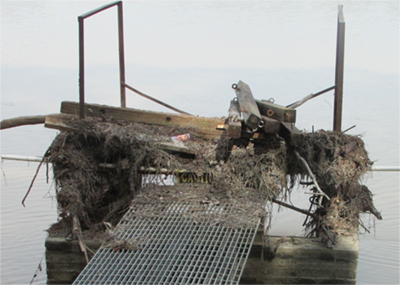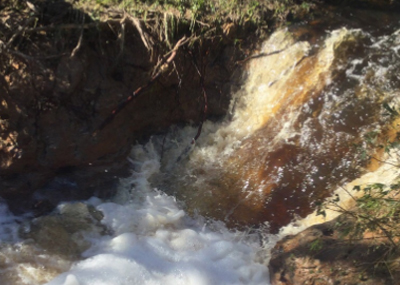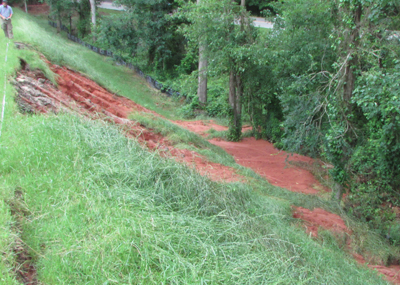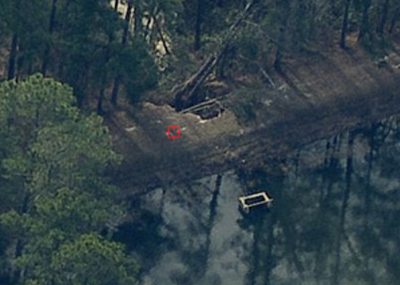If a dam is failing or failure is imminent, your first call should be to 911.
Tropical weather events have caused many South Carolina dams to fail in recent years. Hurricanes and tropical storms can create intense rainfall and strong winds, which can lead to dam damage or failure. Heavy rains can overwhelm a dam's storage ability and lead to dam overtopping, erosion, and failure. Strong winds can topple trees, which can create voids or embankment losses. These can provide uncontrolled pathways for water flow and may lead to the dam eroding or failing.
A dam's failure risk depends not just on the strength of a storm but also on the dam's condition. While even the best maintained dam may not be able to weather the most intense storms, a dam in disrepair can be at risk of failing under less intense or even sunny day conditions. The Dams and Reservoirs Safety Program carries out regular inspections of dams classified of having a High or Significant Hazard Potential but dam owners are the first line of defense. Because dam owners can observe their structures more frequently then the Program inspection cycle, they will be able to identify potential dam deficiencies early and address them before they can weaken the integrity of the dam or increase the dam's vulnerability to a major storm. Dam owners are also best suited to initiate an emergency response if their dam experiences a potential or total failure. When severe weather approaches, the Program encourages dam owners and operators to prepare as best they can and be ready to respond if necessary.
Preparation
When a significant rainfall event or a storm that can generate high winds is imminent, dam owners should:
- Evaluate the current water level behind the dam and determine if the water level needs to be safely lowered to provide extra capacity for incoming flows
- Coordinate any water release with other dam owners and/or property owners downstream that could be impacted
- If it is safe to do so, routinely clear debris from spillways to prevent clogging or redirection of flow.
- Review your Emergency Action Plan and ensure it is up to date and that you know who you may need to contact in an emergency
- Monitor the dam and the water level as the storm progresses and initiate the Emergency Action Plan if the dam is near failure or has failed
Controlling Water Level
The best way to protect your dam from failure is to have additional storage capacity available to handle storm rainfall and to have an effective way to lower water in the reservoir. This prevents the dam from overtopping, which can rapidly lead to dam failure and the entire reservoir being released. Please ensure spillways are functioning and clear of debris before the storm arrives to ensure that water can be drained from the reservoir. Preemptively lowering the reservoir level can provide extra capacity to handle the storm and prevent overtopping. If the water level in your dam cannot be lowered in a controlled way, either because spillways are not present or are not functioning, please contact the program immediately. As a short-term measure, you may be able to install temporary siphons to provide additional drainage capacity. These may assist as a stopgap in preparation for tropical weather and other large rainfall events and in response to an emergency at your dam but should not be relied on for long-term water control. Additional details about temporary siphons and preparing for storms can be found in our instructional video and technical bulletins, available below.
Instructional Video on Assembling a Temporary Siphon
Carefully Assess Your Dam
Once the storm event has passed and it is safe to do so, please conduct a brief visual inspection of your dam. If the storm has caused damage to the structure, you should take steps to address the damage as soon as possible. Some maintenance activities can be conducted without a department-issued permit but for more significant repairs, a permit may be required. If you have detected a potential problem at your dam and wish to learn more about what activities are considered maintenance and which require a permit, please contact the Dam Safety Program staff at 803-898-1939.
While you should fully assess your dam after a storm, particular areas of concern are:
Debris-clogged spillways. Remove accumulated debris if it is safe and feasible to do so.
Major Erosion. This may impact the dam's integrity and may need to be repaired under a permit. Please contact the program for assistance
Large slumps or slides Check for new or larger slumps or slides in the earthen dam and contact the program immediately if observed. These can impact the integrity of the dam.
If dam failure appears imminent, implement your Emergency Action Plan immediately. If you do not have a plan, call 911 and County Emergency Management Contacts
You may report any concerns or damage to DHEC Dam Safety Program staff at any time at our 24hr technical assistance line at 803-898-1939



